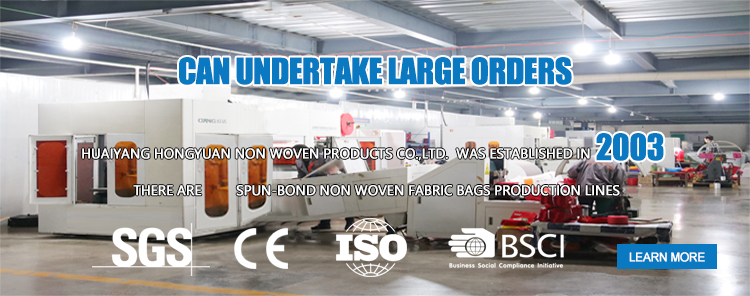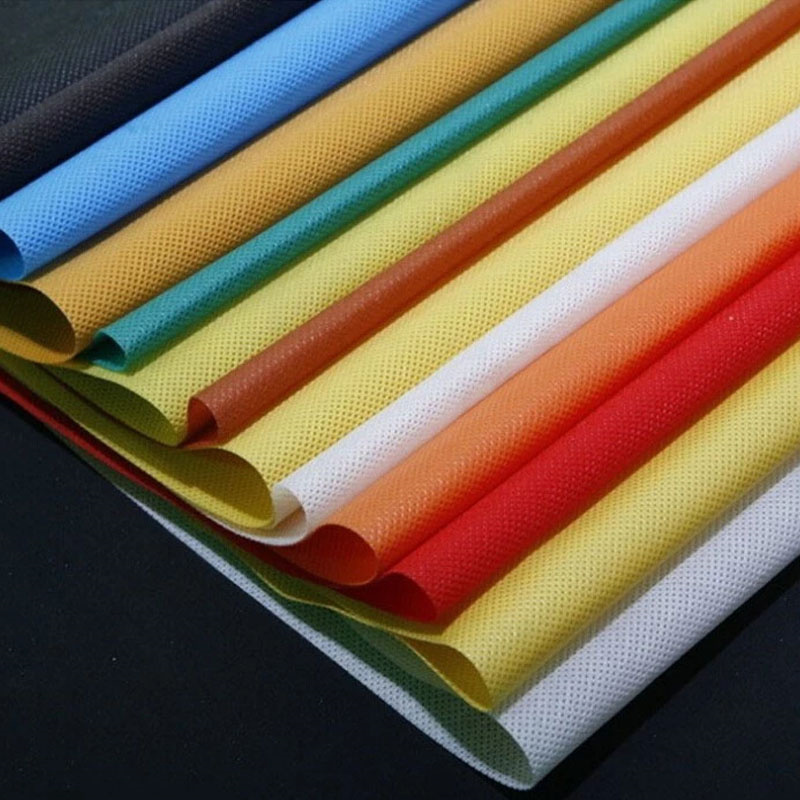
Non-woven fabric is a fabric-like material, made of short fibers (short fibers) and long fibers (continuous long fibers), which are bonded together through chemical, mechanical, thermal or solvent treatment. This term is used in the textile industry to refer to fabrics that are neither woven nor knitted, such as felt.

Non-woven fabric manufacturing process and its application
According to different manufacturing processes, non-woven fabrics can be divided into 8 categories:
Spunlace non-woven fabric: it is a kind of non-woven fabric, which directly uses polymer chips, short fibers or filaments to form a fiber network through air or mechanical, spunlace, acupuncture or hot rolling, and finally forms a spunlace after finishing Non-woven fabric. Uses: Widely used in facial mask fabrics, medical non-woven fabrics, wet wipes, non-woven filter cloths and other fields.
Thermally bonded non-woven fabric: This non-woven fabric is mainly manufactured through several processes: adding fibers or viscous reinforcing materials to the fiber network, and then strengthening the network into the cloth through heating and cooling.
Pulp air-laid non-woven fabric: Air-laid non-woven fabric can also be called dust-free paper or dry paper non-woven fabric. It uses airflow laying technology to open the wood pulp fiberboard into a single fiber state, and then uses the airflow method to condense the fibers on the mesh curtain, and then consolidate the fiber mesh into a cloth.
Wet-laid nonwovens: The manufacturing process of wet-laid nonwovens is as follows: open the fiber raw materials in the water medium into single fibers, and mix different fiber raw materials to form a fiber suspension slurry, and then transport the suspended slurry to the web forming mechanism , The fiber is laid into a cloth in a wet state.
Spunbond nonwoven fabric: The processing method of spunbonded nonwoven fabric is as follows: extrude and stretch the polymer to form a continuous filament, lay the filament into a net, and then use self-bonding, thermal bonding, and chemical bonding Combine or mechanical reinforcement method to process the net into a non-woven fabric.
Melt-blown non-woven fabric: Melt-blown non-woven fabric is made by extruding molten polymer fibers through a linear die containing hundreds of small holes to form elongated fibers. When these fibers fall from the linear die, they pass through The hot air is stretched and cooled, and then the formed fiber web is blown onto the dust collecting screen to form a finely filtered self-adhesive non-woven fabric. Usually, such non-woven fabrics are added to spunbond fabrics to form SM or SMS webs.
Needle-punched non-woven fabric: Needle-punched non-woven fabric is a dry non-woven fabric. The fluffy fibers are reinforced by needle punching into a cloth.
Stitched nonwoven fabric: Stitched nonwoven fabric is another dry nonwoven fabric. The manufacturing process uses a warp-knitted loop structure to reinforce fiber webs, yarn layers, non-woven materials (such as plastic sheets, plastic foils, etc.) or a combination thereof to form a non-woven fabric.
Non-woven fabric market: The size of the non-woven fabric market is expected to grow from US$22.62 billion in 2016 to US$34.85 billion in 2022. During the forecast period, the market is expected to grow at a compound annual growth rate of 7.51%. The base year considered in this study is 2016, and the market size is estimated to be from 2017 to 2022.
Manufacturing of non-woven fabrics
Raw material: The raw material of the non-woven fabric is given in the flow chart.
Natural fibers: cotton, jute, flax
Recycled fiber: bamboo fiber, viscous fiber, tencel, modal fiber.
Synthetic polymers: PP, PE, PET, nylon, PA, polyester, PCL, PLA
The main method of manufacturing non-woven fabrics
Felt
According to the American Society for Testing and Materials (ASTM), felt is a structured structure formed by fiber interlocking through the proper combination of mechanical action, chemical action, moisture and heat, without spinning, weaving or weaving. Other felt fabrics: cotton felt, jute felt, linen felt, synthetic fiber felt fabric.
Manufacturing process: The felt can be manufactured manually or mechanically. The manufacture of machine-made felts is as follows. The fiber undergoes two consecutive carding operations, and the two carding operations make the fibers parallel in the form of a fine web and have a uniform thickness. Before accumulating enough weight or thickness, several layers of webs should be built. Then cut the mass or batting (web layer) and trim the edges to the desired width. Cotton wool is usually about 37 meters long, 150-230 cm wide, and weighs between 8-23 kg. Sprinkle the cotton wool evenly with warm water, heat the fabric thoroughly through the steam box, and then press between the two rollers. The upper roller rests on the cotton wool and exerts pressure through a swinging motion. The pressure combines with moisture and heat to produce the final bonding effect. Then let them drain and cool for about 24 hours.
application
Geotextiles (road construction, railway line construction, river bank construction), mattresses, foam, floor coverings, composite materials.
Bonded non-woven fabric:
The nonwoven web forming method is classified according to the form of the raw materials selected for the specific application. Short fibers and filaments are used to make nonwoven webs.
Bonded nonwoven technologies include:
Dry shop
Wet paving
Polymer melt/spinning melt
Dry-laid web forming: Dry-laid web forming is an ancient technology, very similar to the felting process. For the production of dry-laid webs, a carding machine and a web winder are used to layer the fiber batt. The fibrous web layers are then bonded by heating, dampening and stirring. These materials can be natural or synthetic polymer compositions, which can be processed individually or mixed together. Carded nets are made of short and short fibers (20-60 mm) or long and short fibers (50-150 mm).
Dry-laid web technology, such as fiber preparation, blending, carding and collection, is an innovation in the textile industry. These processes prepare short fibers, mix them, and layer the fiber batt in a dry state. In dry-laid web forming, the fibers are collected into a web by parallel grinding, cross grinding or pneumatic (air-laid) grinding and forming, and then bonded by mechanical needles, hydraulic winding, chemical adhesives and thermal bonding methods.
Raw materials: cotton fiber, synthetic fiber, viscose fiber, short cotton fiber.
Application of dry laying method: diapers, baby wipes, female napkins, tampons, adult urinary incontinence products, medical textiles
Wet-laid web forming: Wet-laid web forming can be regarded as similar to the traditional papermaking process, but the use of chopped synthetic fibers or short fibers continues to receive attention as an advantageous way to prepare advanced nonwoven textile products. The wet-laid web forming system is designed to produce short fibers dispersed in a liquid, which are then layered. The wet-laying method is particularly suitable for the mass production of disposable products, such as tea bags, aprons, gloves, napkins and surgical gauze.
Raw materials: Various lengths of natural, wood pulp, mineral, synthetic and man-made fibers can be used, such as glass, polyester, polyamide and recycled fibers.
Uses: filter paper, tea bag cloth, napkins, surgical gauze.
Melt-spun nonwoven fabric: Melt-spun nonwoven fabric is a general term that describes the manufacture of nonwoven fabric directly from thermoplastic polymers. It includes two processes,
Spunbond nonwoven fabric
Meltblown nonwoven fabric
Spunbond (bonded) nonwovens: polymer particles are extruded into filaments through so-called spinnerets. The continuous filaments are stretched and quenched before being placed on the conveyor belt to form a uniform web. Due to the attenuation of filaments, compared with carding, the spinning-laying process can increase the strength of the nonwoven fabric. The disadvantage is that the choice of raw materials is more restricted. The coextrusion of the two components results in bico fibers, either adding more properties to the fiber web, or allowing air to pass through the bond. Please note that the term "spunbond" is reserved for thermally bonded spunbond.
Raw materials: PP (polypropylene), Pet, nylon, PE, polyester. (Synthetic thermoplastic resin).
Uses: packaging (shopping bags), medical PPE,
Meltblown nonwovens: Meltblown, like spinning, starts by extruding low-viscosity polymers. But when the filament leaves the spinneret, the filament is not quenched, but diluted by the hot air flow, keeping the filament in a partially molten state. This will result in thinner filaments with lower tensile strength. The filament hits the belt or conveyor belt, forming a net.
Raw materials: polypropylene (PP), polyamide (PA), polyester, polyethylene (PE).
Some processed polymers are:
Polypropylene is the most used polymer in meltblown technology.
Polypropylene is easy to process and is a good mesh.
Polyethylene is more difficult to melt and blow into the fine fiber web than polypropylene.
Polyethylene is difficult to stretch due to its melt elasticity.
PBT is easy to process and produces a very soft and fine fiber web.
Nylon 6 is easy to process and makes a good net.
Nylon 11 is melt blown into a net with a very unusual leather-like touch.
Polycarbonate produces a very soft fiber web.
Polystyrene produces an extremely soft, fluffy material, basically free of shot peening defects
Manufacturing process: Meltblown technology is based on the meltblown process, usually thermoplastic fiber forming polymer is extruded through a linear die containing hundreds of small holes. The convergent hot air stream rapidly attenuates the extruded polymer stream, forming extremely fine fibers (1-5 microns). Subsequently, the attenuated fibers are blown by high-viscosity air onto the collector conveyor, thereby forming a fine fiber self-adhesive non-woven fabric.
Uses: filter paper, N95 mask (used as filter cloth), PP gown, surgical mask, napkin, tea bag cloth, water filter. Face mask, wrap, tea bag, silicone bag
, Sanitary materials, warm filling materials, filter materials, diapers and sanitary napkins
Facial mask
N95 mask: N95 mask is a respiratory protection device designed to achieve a very close fit on the face and very effective air particle filtration.
The "N95" logo means that the respirator will block at least 95% of the very small (0.3 micron) test particles when carefully tested. If installed correctly, the filtering capacity of the N95 respirator exceeds that of the mask. However, even the correct installation of N95 respirators cannot completely eliminate the risk of illness or death. Surgical N95 respirators are commonly used in medical environments and are a subset of N95 filtration.
Manufacturing process: 5 layers of fabric.
Surgical mask: A surgical mask is a loose, disposable device that forms a physical barrier between the wearer’s mouth and nose and potential contaminants in the surrounding environment. These masks are often called masks, although not all masks are regulated as surgical masks.
Test fluid resistance and filtration efficiency (particle filtration efficiency and bacterial filtration efficiency). It should not be shared or reused.
Manufacturing Technology:
Material: Three-layer surgical mask made of SMS fabric.
SMS spunbond method meltblown spunbond method.
<< previous
next >>